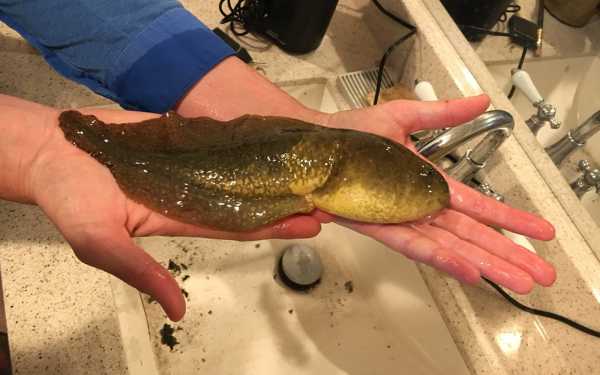
So, so thicc.
UPDATE: The tadpole titan affectionately known as “Goliath” died in 2019, according to a tweet written on May 26, 2020 by herpetologist Earyn McGee; she introduced Twitter to Goliath in 2018, when this article was originally published. Scientists with the Southwestern Research Station in Arizona preserved the tadpole and are studying it to better understand its unusual size and morphology, according to the tweet.
An enormous tadpole found in the wild is bigger than a can of Coke — and it’s still growing.
Biologists discovered the sizable swimmer in a shallow pond in southeastern Arizona; they were removing invasive American bullfrogs (Lithobates catesbeianus) with the Southwestern Research Station (SWRS), a year-round field station run by the Science Department at the American Museum of Natural History in New York City.
As a volunteer probed a mostly drained pond, she stumbled upon an oversize bullfrog tadpole — the wriggly amphibian was so big that the volunteer initially thought it was a fish, herpetologist Earyn McGee, a doctoral candidate at the University of Arizona and a scientist at SWRS, wrote in a blog post on July 23.
What’s the story behind this massive weirdo, which biologists have nicknamed “Goliath?”
McGee tweeted photos of Goliath on June 13, generating more than 13,000 likes and drawing dozens of curious commenters. She explained that Goliath was definitely much larger than the average American bullfrog tadpole, suggesting that his unusual size was likely due to “some sort of hormone imbalance.” Researchers at SWRS suspect that this imbalance will likely prevent poor Goliath from ever metamorphosing into a frog, and they are currently investigating what may have caused his unusual condition, McGee wrote.
McGee told Live Science in an email that prior studies describe tadpoles that are similarly massive, but Goliath was the biggest tadpole that she had ever seen in person. And for a growing tadpole, bigger isn’t necessarily better, McGee added.
“The drawbacks of Goliath’s size is that his respiratory and circulatory system may not continue to support his body size as he continues to grow,” she said. On the other hand, a really big bullfrog tadpole would be able to grab more food than smaller tadpoles, which could work out in a giant’s favor if food supplies in a small pond are low, McGee explained.

American bullfrog tadpoles typically grow to be about 6 inches long — but not Goliath.
American bullfrogs are the biggest of the North American frogs. They grow to lengths of 8 inches (20 centimeters) or longer, and weigh as much as 1 pound (0.5 kilograms), while tadpoles typically grow to be about 6 inches (15 cm) long, according to the U.S. Fish and Wildlife Service (FWS). The frogs are native to central and eastern states, but were introduced in the southwest in the 1900s because of the widespread popularity of frog legs as food, and can now be found in all lower 48 states, according to the FWS.
Researchers at SWRS brought Goliath back to the station and placed him in a tank for closer examination. To provide a sense of the tadpole’s substantial size, one of McGee’s photos positioned Goliath next to a banana, and another photo compared him to a can of Coke. His exact measurements — along with data about his growth rate, feeding habits and behavior — are being collected by scientists for a peer-reviewed study, McGee wrote in a tweet.
Original article on Live Science.
Sourse: www.livescience.com





